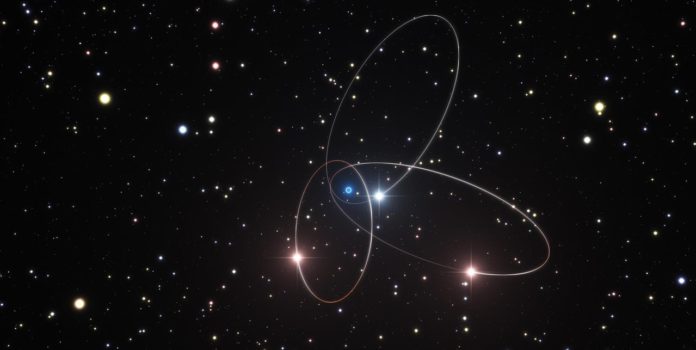Einstein’s theory of General Relativity or the planets.
According to the latest analysis, the orbits of stars around the supermassive black hole at the center of the Milky Way may show the subtle effects predicted by Einstein’s theory of General Relativity. This new analysis by the European Southern Observatory’s (ESO) very large telescope along with other telescope hints that the orbit of the star S2 is deviating slightly from the path calculated using classical physics.
This indicates much accurate measurements and test by using the gravity as Star S2 will pass very close from the supermassive black hole.
Currently, the supermassive black hole is 26 000 light-years from Earth which has a mass four million times that of the Sun. This giant is also surrounded by a bunch of stars circling in the solid gravitational field of the dark gap.
To discover that, scientists applied a new technique to observational data of the stars. They then compared the star orbits actually measured with those predicted by both classical Newtonian gravity and general relativity.
Scientists found that a slight change in the motion of S2, one of the stars. However, the change is small as one-sixth of a degree in the orbit’s orientation and few percent of orbit’s shape. This marks the first time that the strength of the general relativistic effects has been measured for stars orbiting a supermassive black hole.
The change occurs due to relativistic effects. On the off-chance that affirmed, this would be the first occasion when that an estimation of the quality of the general relativistic impacts has been accomplished for stars circling a supermassive dark opening.
Marzieh Parsa, PhD student at the University of Cologne said, “The Galactic Centre really is the best laboratory to study the motion of stars in a relativistic environment. I was amazed how well we could apply the methods we developed with simulated stars to the high-precision data for the innermost high-velocity stars close to the supermassive black hole.”
Its high accuracy of the positional measurements near-infrared adaptive optics instruments. These were vital not only during the star’s close approach to the black hole but particularly during the time when S2 was further away from the black hole. It also provided more accurate measurements of the black hole’s distance from Earth and its mass.
Andreas Eckart, team leader at the University of Cologne said, “As well as more precise information about the orbit of the star S2, the new analysis also gives the mass of the black hole and its distance from Earth to a higher degree of accuracy.”
